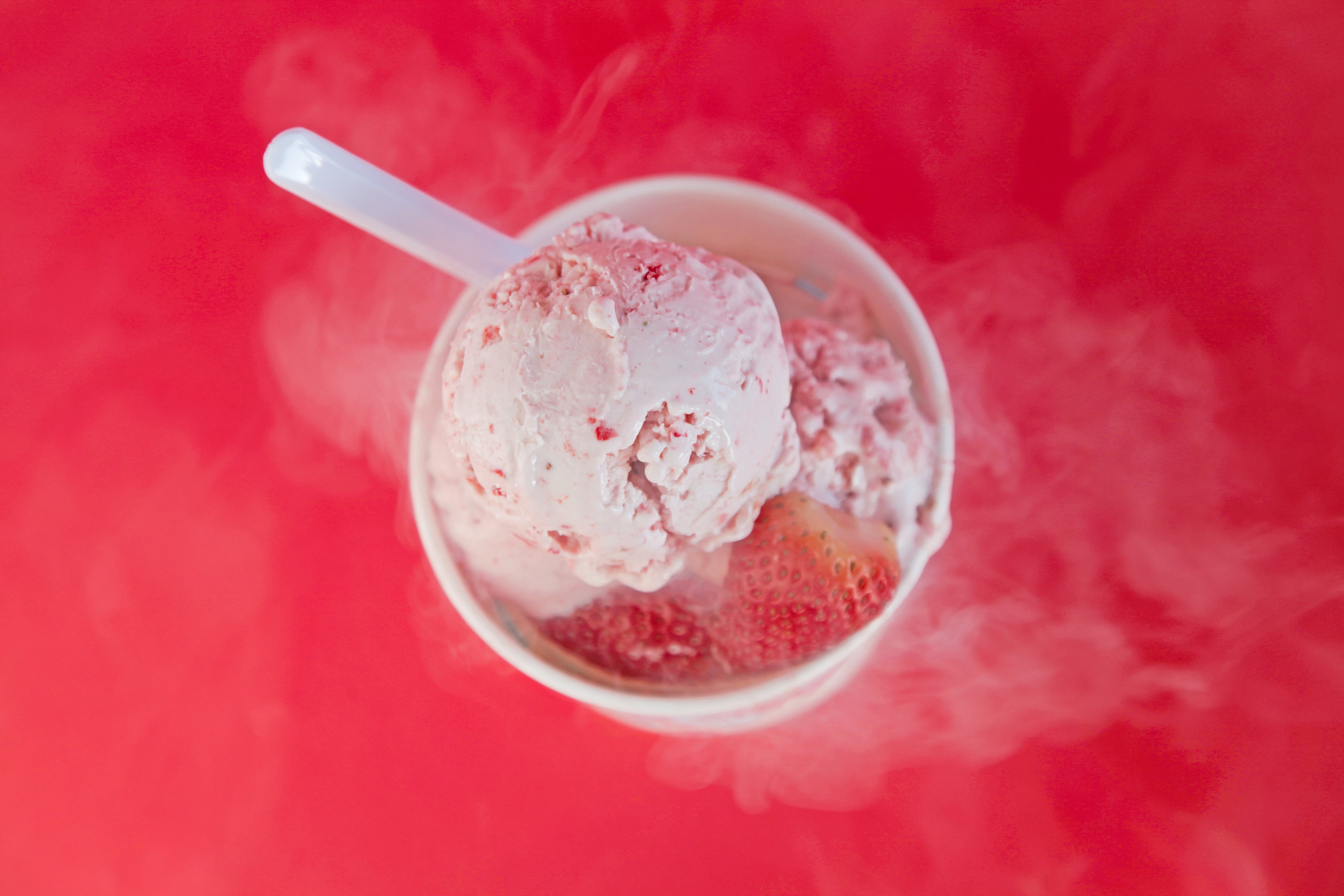Invented in the 1980s, liquid nitrogen (LN2) ice cream has remained a small niche within the wider segment – with barriers ranging from cost of production to shelf stability hindering its growth.
LN2 ice cream: the chemistry
Liquid nitrogen (LN2) boils at –196 °C/ –321°F, meaning that it would freeze ice cream within seconds when it hits the mixture.
In addition, LN2 causes ice crystals to form so fast there is no need for churning. For dairy-based mixes, lactose crystals – which can cause a sandy texture – also do not form, resulting in a smooth texture.
(Sources: Royal Society of Chemistry; American Chemical Society)
The idea of using ‘liquid air’ to make ice cream is credited to US entrepreneur and microbiologist Curt Jones, who invented the American frozen snack Dippin’ Dots in 1988 by flash-freezing ice cream in liquid nitrogen.
Since then, concocting LN2 ice cream has evolved from a party trick to an exciting offering at ice cream parlors – with customers typically witnessing their dessert ‘go up in smoke’ and being able to customize it to their preference just moments after it’s been made from scratch.
With the super-premium ice cream category poised for growth, could 2025 see LN2 ice cream break out of its niche?
We chat to David Leonardo, CEO of liquid nitrogen ice cream company Chill-N, to get the scoop – including on the firm’s unique mail order system and its approach to reducing production costs.
DairyReporter: What sets liquid nitrogen ice cream apart from traditional dairy-based ice creams?
David Leonardo: Liquid nitrogen ice cream offers a completely different experience compared to traditionally churned ice cream. By flash-freezing the base at -320°F, ice crystals remain exceptionally small, resulting in a creamier, smoother texture than conventional ice creams. Additionally, the made-to-order process allows for full customization, meaning every customer can create their own unique flavor combination on the spot. This not only enhances the customer experience but also eliminates the need for large-scale storage and preservatives, keeping our product fresh and high-quality.
DR: How’s the nitrogen ice cream market in the US shaping up in recent years? What competition do you have and what type of consumer does this dessert appeal to?
DL: The nitrogen ice cream market has grown steadily as consumers increasingly seek personalized, premium experiences. While it remains a niche within the broader ice cream industry, the demand for high-quality, customizable treats continues to rise.
There are only a handful of well-known nitrogen ice cream brands in the US and Chill-N ice cream is one of the leaders in the space with almost 17 locations across four states.
Our customers range from families and kids looking for a fun, engaging dessert experience to food enthusiasts who appreciate the freshness and creaminess of liquid nitrogen ice cream.
Additionally, we’re seeing increased interest from health-conscious consumers due to our ability to cater to dietary preferences like keto, dairy-free, and no-sugar-added options.
DR: How expensive is it to make nitrogen ice cream and what’s the price of a single scoop in the US?
DL: The production cost of nitrogen ice cream is generally higher than traditional ice cream due to the specialized equipment, liquid nitrogen costs, and the made-to-order preparation method.
Unlike traditional ice cream, which benefits from large-scale batch production, nitrogen ice cream is crafted on demand, requiring labor and specialized training.
In the US, we do not serve our ice cream by scoops but instead by volume – but a small serving would equate to 2-3 scoops and typically ranges from $6 to $9, depending on the base selected and the mix-ins you add to your order.
This also reflects the premium positioning of the product as all our ingredients are sourced with quality and value in mind. Many customers see the value in the unique experience, ultra-fresh product, and ability to customize every order.
DR: How has your company tackled the price gap between traditional and nitrogen ice cream?
DL: We’ve streamlined our operations to keep pricing competitive while maintaining a premium experience. Our made-to-order system reduces waste, as we only produce what’s needed for each customer, eliminating inventory spoilage. Additionally, we optimize our labor by introducing technology to automate the dispensing of the bases and control the mixing of the ingredients and dispending of the nitrogen.
All this allows us to produce up to 100 cups per hour with a four-mixer setup and provide each ice cream in under 7 minutes.
We have also entered into national contracts with our distribution company capping the markup on our supplies. In light of all this, we feel we have created a very fast assembly line that can produce custom, ready-to-make ice cream with no waste and in an efficient environment, thus allowing us to reduce costs while maintaining our commitment to high quality.
DR: What are your key flavor and texture considerations when you’re formulating new ice cream offerings – and why?
DL: Texture and creaminess are top priorities since the rapid freezing process enhances the smoothness of our ice cream.
We carefully balance fat and sugar content to maximize the stability and mouthfeel of each flavor.
Our flavor development is driven by customer demand, seasonal trends, and dietary inclusivity – offering everything from indulgent options to lighter, alternative bases like our upcoming Macadamia based No Sugar option.
We currently offer the following bases: Ice cream, Yogurt, Sorbet, Tart, Oat Milk, Coconut Milk, Almond Milk and No Sugar Added. We also emphasize natural, high-quality ingredients across our flavors to ensure the best possible taste and consistency.
DR: Are there any traditional ingredients that can’t be used for making nitrogen ice cream due to the production process involved?
DL: While most traditional ingredients work well with our process, a few require modifications.
High-water-content ingredients, like our sorbet, can freeze too hard when exposed to liquid nitrogen, affecting texture.
This is why every base has a specific algorithm that requires a different amount of nitrogen and timing to complete the ice cream. All this done by our computers attached to each mixer.
Similarly, some emulsifiers and stabilizers used in traditional ice cream aren’t necessary in our process, since nitrogen instantly freezes the base, eliminating the need for extended shelf-life stabilizers.
We also have to be mindful of ingredients that react to extreme cold, such as alcohol-based flavors, which require adjustments to maintain consistency. We currently do not offer any alcohol-infused flavors.
DR: Is there scope for liquid nitrogen ice cream to be sold in grocery stores rather than in a foodservice environment? What are the barriers to achieving this currently?
DL: There is definitely potential for liquid nitrogen ice cream to enter the retail space – but the biggest challenge is shelf stability.
The appeal of nitrogen ice cream lies in its made-to-order freshness, which is difficult to replicate in pre-packaged formats without losing the textural advantage.
However, we are testing ways to bring our product to more consumers through mail-order and direct-to-consumer frozen shipping, which allows us to maintain quality while reaching a broader audience. We are currently the only player in this space for providing mail order ice cream.
Chill-N’s ice cream trend predictions
Functional and Health-Focused Ice Creams
Consumers are looking for low-sugar, dairy-free, and protein-enhanced ice creams that don’t compromise on taste. We see continued demand for plant-based alternatives that feel indulgent but fit into various dietary lifestyles. This line currently represents 25% of our business and growing.
Hyper-Personalization & Customization
The trend toward made-to-order and customizable flavors will continue growing, with brands offering more interactive experiences. Nitrogen ice cream is naturally positioned to thrive in this space.
Expansion of E-Commerce & Direct-to-Consumer Models
Ice cream brands will focus more on mail-order, flash-frozen shipping, and subscription services to meet consumer demand beyond brick-and-mortar locations. We’re actively working on expanding in this space to bring Chill-N’s premium nitrogen ice cream to a larger audience.




